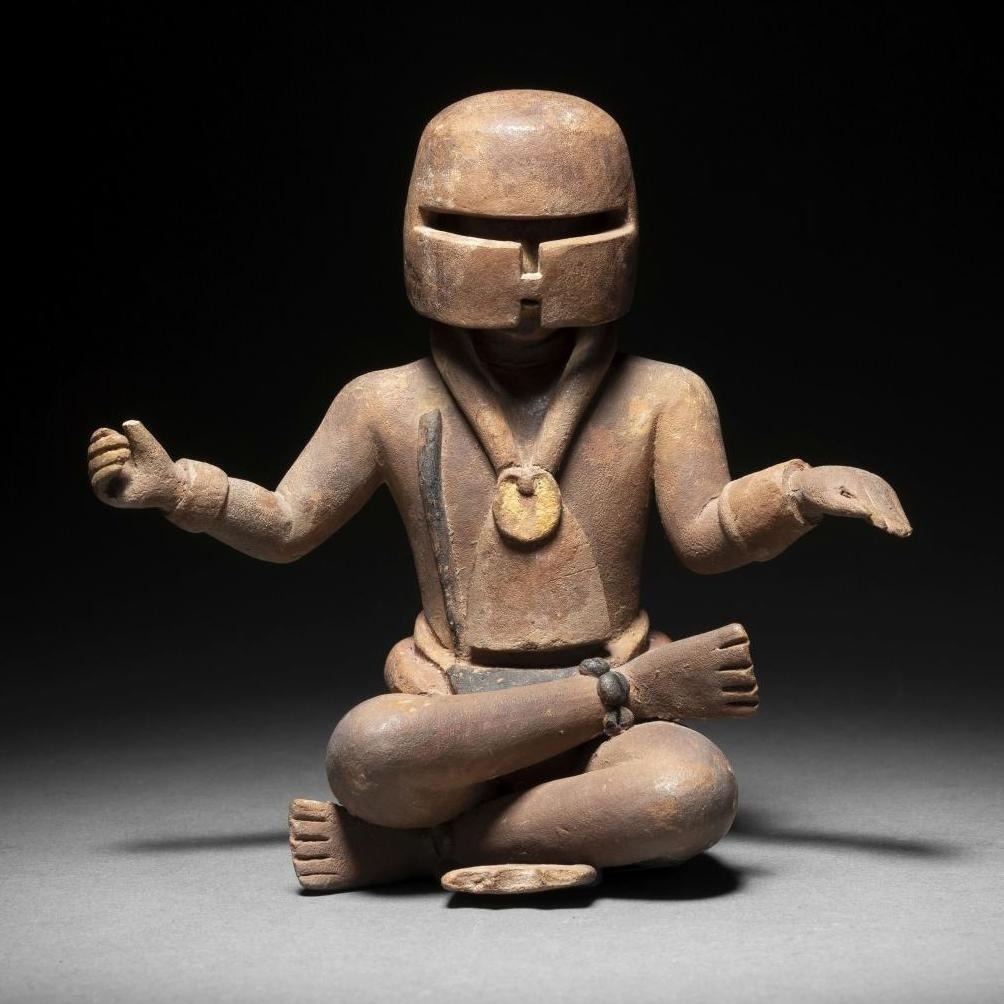The Petén region of Guatemala, rich in archaeological significance, has yielded some of the most fascinating artifacts from the ancient Maya civilization. Among them is a remarkable seated Mayan figure, dating back at least 1,100 years, to the Late Classic Period (600-900 CE). This small yet intricately designed piece offers an extraordinary window into the artistry, culture, and spiritual practices of the Maya people.
A Masterpiece of Maya Craftsmanship
Crafted from brownware ceramic, this seated figure stands at just 12.4 cm (4 7/8 in) tall, with the addition of a removable helmet. Despite its modest size, the level of detail embedded in the figure’s design is remarkable. The figure is adorned with traces of red, blue, and yellow pigments, which emphasize the meticulous craftsmanship of its creators. These pigments would have once been vibrant, signifying the importance of color in Maya culture.

The figure is decorated with various symbolic elements, including a loincloth, ankle bracelets adorned with small bells, and black chapopote (tar) accents on the hair and ornaments. These features suggest that the figure was more than just a decorative object; it may have been created for ceremonial purposes. The bells on the ankle bracelets, in particular, could have served as a ritualistic tool, resonating with the sacred or symbolic sounds during religious ceremonies.
Ceremonial and Symbolic Significance
The removable helmet is a striking feature, hinting at the figure’s possible role in Maya rituals. Helmets in ancient Maya culture were often associated with authority, warrior status, or divine connection, and their detachable nature might indicate the figure’s use in ceremonial settings. The inclusion of these details suggests that the figure might have represented a deity, a ruler, or a warrior—figures central to Maya religious and political life.
The presence of such items reflects the Maya’s complex understanding of power, identity, and divinity. The design is likely symbolic, portraying an idealized form that reflects the values of the time, potentially invoking divine protection, fertility, or warfare—common themes in Maya art and religion.
Provenance and Scholarly Attention
This exceptional artifact has passed through several prestigious collections. It was once part of the private collection of Dr. and Mrs. Robert Kuhn in Los Angeles. In 1991, it was acquired by its current owner from Ancient Art of the New World in New York, further adding to its provenance. The figure’s significance is underscored by its publication in respected scholarly works, such as The Art of the Maya Scribe by Michael D. Coe and Justin Kerr (1997), and Unpublished Masterpieces of Pre-Columbian Art by Michel Graulich and Lin Crocker (1985).

These publications highlight the figure’s importance in the context of Maya art and culture, cementing its place in the study of pre-Columbian artifacts. Its presence in these scholarly works speaks to its value in understanding the material culture of the Maya civilization and its connection to broader themes of power, identity, and spiritual practice.
A Testament to Maya Cultural Legacy
This Mayan seated figure is not just an example of intricate craftsmanship; it is a testament to the rich cultural, spiritual, and artistic traditions of the ancient Maya. Through its detailed design and symbolic elements, the figure offers a glimpse into the sophisticated worldview of the Maya civilization during the Late Classic Period. The artifact invites us to reflect on the Maya’s complex understanding of the world, where art, religion, and politics intertwined to shape their identity.
By continuing to study and preserve such artifacts, we gain valuable insight into the social and cultural dynamics of the ancient Maya, allowing their legacy to live on. This seated figure is not only a beautiful work of art but a symbolic link to a civilization that continues to captivate the world with its complexity and richness.
